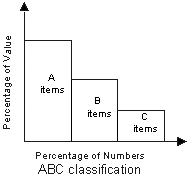Inventory Control: Objectives, Advantages, Techniques of Inventory Control
Objectives of Inventory Control
- To minimize the possibility of delays in production through regular supply of raw materials.
- To keep inactive, waste, surplus, scrap and obsolete items at the minimum level.
- To maintain the overall investment in inventory at the lowest level, consistent with operating requirements.
- To exercise economies in ordering, obtaining, and storing of the materials.
Advantages of Inventory Control
- It enables the material to be procured in economic quantities.
- It eliminates delays in production caused by the non-availability of required materials.
- It works as a check on the over accumulation of inventories and thereby results in minimum investment consistent with production requirements.
- It reduces inventory losses caused by inadequate inspection of incoming materials and losses due to obsolescence, deterioration, waste and theft while in storage.
- It ensures proper execution of policies covering procurement and use of materials. It also facilitates timely adjustment with changing conditions in the market.
Techniques of Inventory Control
- ABC analysis
- VED analysis
ABC analysis
Under this technique, the inventory items are divided into three groups, viz., A, B and C on the basis of the investment involved.
| Category (or group) |
Percentage of the items |
Percentages of the total annual value of the inventories (Rs.) |
|---|---|---|
| A | 10-20 | 70-85 |
| B | 20-30 | 10-25 |
| C | 60-70 | 5-15 |

In fact, ABC analysis indicates the items of raw materials to be controlled by managers at different levels. The managers are responsible for ensuring optimal investment in raw materials.
VED analysis
This analysis consists of separating the inventory items into three groups according to their critically as under:
- Vital items (or V items) – These items are considered vital for smooth running of the system and without these items the whole system becomes inoperative. Thus, close attention is paid to V items.
- Essential items (or E items) – These items are considered essential for efficient running of the system.
- Desirable items (or D items) – The availability of these items help in increasing the efficiency.
The criticality of the item may either be on technical grounds or on environmental grounds or on both.
ABC analysis coupled with VED analysis enhances the efficiency of control on inventories.



